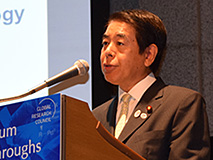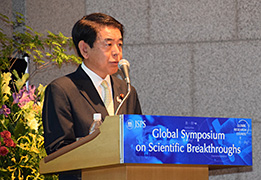お問い合わせ先
独立行政法人 日本学術振興会
国際統括本部 国際企画部
国際企画課
〒102-0083
東京都千代田区麹町5-3-1
Tel 03-3263-1938
Fax 03-3234-3700
Email horcs@jsps.go.jp


(日本語訳)※英語原文は日本語の後に掲載しています。

シンポジウムの冒頭に講演の機会をいただき、ありがとうございます。
安倍政権のアベノミクスによる経済政策が確実に成果を上げつつあります。我が国が持続的に成長し、世界の経済・社会に貢献していくためには、ブレークスルーを生み出すことが必要であり、このブレークスルーが絶え間ないイノベーションの鍵となります。
本日は、科学上のブレークスルーを生み出し、イノベーションによる我が国の発展につなげるため、文部科学省が今後取り組む教育、科学技術・学術政策の方向性について、2つのトピックをお話しします。
1つ目のトピックは、これからの新しい時代に対応する抜本的な教育改革です。
ニューヨーク市立大学大学院のデビッドソン氏は、2011年に米国の小学校に入学した子供たちの65%は、大学卒業後、今は存在していない職業に就くと指摘しています。オックスフォード大学のオズボーン氏は、今後10年から20年程度で、米国の約47%の仕事が自動化される可能性が高いと予測しています。このように現在の職業の多くがなくなっていくことは、米国だけでなく日本を含めた先進諸国に同様の問題だと考えています。
このような、先を見越すことの難しい時代においては、課題解決力、創造力、人間特有の感性や優しさを身に着ける「真の学ぶ力」が必要です。このため、高等学校以下の教育、大学教育、大学入試を一体的に改革しています。
その中で、イノベーションの担い手である国立大学の改革も積極的に進めてまいります。
昨年の通常国会で成立した大学のガバナンス改革に関する法律が4月より施行され、学長がリーダーシップを発揮する基盤が整いました。国立大学は危機感をもって自己改革を進め、学問の進展やイノベーションの創出に大きく貢献できる組織へと再編・転換する必要があります。
今後、大学自らのビジョンに基づく機能強化を推進するため、国立大学法人運営費交付金に3つの重点支援の枠組みを新設し、「地域のニーズに応える人材育成・研究」「分野毎の優れた教育研究拠点やネットワークの形成」「世界トップレベルの卓越した教育研究」といった改革構想に基づき、自己改革を積極的に取り組む大学に、国はメリハリのある資金配分を行います。

2つ目のトピックは、ブレークスルーを生み出し、社会へ貢献するための科学技術・学術政策です。
科学技術によって社会に新たな価値を提供するには、イノベーションの源泉としての学術研究及び基礎研究の改革を強化することが重要です。これらを大学改革と一体的に推進することで、「世界で最もイノベーションに適した国」を目指します。
組織や国を超えたオープンイノベーションへの転換も進んでいる状況においては、研究者の自由な発想に基づく学術研究を振興するとともに、自ら課題を発見し未知のものに挑戦する人材を育成することで、独創的で多様な広がりを持つ質の高い知を常に生み育て、重層的に蓄積しておくことが必要です。
昨年、赤﨑勇氏、天野浩氏、中村修二氏の日本人3名がノーベル物理学賞を受賞されました。3名の方々は一度や二度の失敗には屈せず、努力を続けてこられた結果、青色LEDに関する大きな成果を生み出しました。
また、山中伸弥教授の作ったiPS細胞の研究は、2012年のノーベル生理学・医学賞受賞もあり、今や世界中の人が知るところとなりました。文部科学省では10年間で1,100億円の集中的な支援を行っていくこととしており、昨年iPS細胞を用いた世界初の網膜の移植が実現する等、成果を上げているところです。
ここで強調したいのは、我が国では、これらの研究が世界から脚光を浴びるはるか以前の段階から、その可能性を見出し、支援を行っていたということです。研究者の自主性・自律性を前提とした学術研究に対し、短期的成果にとらわれず、継続的な研究支援を行うことが、真のイノベーションの創出につながると確信しております。
現在、文部科学省では、我が国最大の競争的研究費として、自然科学から人文学・社会科学まで、すべての分野における多様な学術研究を支援する科研費の改革を進めています。科研費全体のプログラムや審査の抜本的な見直し、「国際共同研究加速基金」の創設等を行い、分野・組織・国境等の壁を越えた知の融合によるブレークスルーの創出を目指します。
そして、科研費から生まれた「イノベーションの種」を拾いだし実用化に向けて加速するため、政府が示す目標を達成するための「戦略研究」とのシームレスな連携の仕組みを構築します。
また、産学官の力を結集した中核拠点の形成や産学官での人材循環によるイノベーションを推進します。
とりわけ、省エネルギーイノベーションは最重要分野です。今後、照明のLED化が進めば、消費電力は現在より7%削減されるとの試算があります。天野教授らが研究を進めているパワー半導体の高効率化により、さらに7%の電力消費削減が実現されるとのことです。文部科学省では、パワー半導体研究に携わる若手研究者を集中支援するとともに、天野教授のいる名古屋大学を中核拠点として、産学官連携による研究開発イノベーション拠点の構築に取り組みます。
これにより、2035年までかかると言われているパワー半導体の高効率化を10年前倒し、2025年までの実現を目指します。
今回のシンポジウムが御参加の皆様にとって有意義なものとなるとともに科学上のブレークスルーの意義を社会に発信し、理解を促進させるものになることを祈念します。
御清聴ありがとうございました。
(英語原文)
Thank you very much for allowing me to speak here today.
Abenomics, the Abe administration’s economic policy, is showing definite results. We feel scientific breakthroughs are vital for Japan’s continuing growth and our contributions to the global economy and society. Breakthroughs are the key for constant innovation.
Today I would like to speak about two topics regarding the direction of MEXT’s education and science and technology policies from now. These policies will lead to Japan’s growth by creating breakthroughs and spurring innovation.
The first topic is the drastic educational reforms we will carry out from now to respond to the needs of the new era.
Cathy Davidson, a professor at The Graduate School and University Center of The City University of New York made a very telling point: 65 percent of American children entering elementary school in 2011 will end up working in careers that do not even exist now. Michael Osborne of Oxford University estimates that almost 47 percent of the jobs in the United States will likely be computerized within one or two decades. I believe that this disappearance of many of our current jobs will be a problem in not only the United States but in all advanced countries, including Japan.
We live in an age when the genuine ability to learn is vital. This means the ability to solve problems, to create, and to cultivate the sensibility and grace unique to humans. Because of this reality, we will carry out integrated reforms of high school-and-under education, university education, and the university entrance exam system, which connects them.
Among these efforts, we will actively reform national universities, the spearheads of innovation.
The law for reforming university governance went into effect this past April. This means that university presidents can now exercise positive leadership for reforming the way universities are run. National universities must urgently reform themselves. They must change and remake their systems with the aim of advancing scholarship and innovation.
We want universities to become better, based on their own vision. For this, we have built a new framework for providing operating grants to national universities. There are three priority areas for support: one, the fostering of human resources who can meet society’s needs; two, the creation of first-rate educational research hubs and networks in every field; and three, the promotion of world-class research. Based on this reform initiative, the government will provide funds in a clear and focused way to universities that are actively undertaking self-reforms.
My second topic is science and technology policy for creating scientific breakthroughs that will contribute to society.
Science and technology can provide new values for society. For this, we must strengthen reforms for spurring academic research and basic research, which are the fountainheads for innovation. By promoting these reforms in an integral way with the overall university reforms, we are aiming to make Japan the world’s most innovation-friendly country.
We are seeing a switch to open innovation, which transcends institutions and national borders. With this as a new norm, we must constantly create and amass high-quality knowledge that is diverse and creative. To do this, we must promote academic research that is based on the freely developed ideas of researchers. And we must foster people who want to find new areas of research and to challenge the new and unknown.
Last year, three Japanese researchers – Isamu Akasaki, Hiroshi Amano, and Shuji Nakamura – won the Nobel Prize in physics. Not giving into failure and working hard, the three achieved great results in producing blue light LEDs.
Professor Shinya Yamanaka’s research on iPS cells also won him a Nobel Prize in 2012. His discovery is now known by many people around the world. MEXT is intensively providing 110 billion yen for iPS research over ten years. Promising results in this field have already been achieved. For example, last year saw the world’s first transplant of a retina using iPS cells.
I want to stress one point. In Japan, we have constantly tried to uncover the potential of academic research and to support this research from the earliest stage, before it captured the world’s spotlight. We believe that providing continuous support for research, without being a slave to short-term results, leads to the creation of genuine innovation.
At MEXT, we are currently reforming our system for Grants-in-Aid for Scientific Research, called KAKENHI. This is Japan’s most competitive research funding, supporting diverse academic research in all fields.
We are completely reviewing all the KAKENHI programs and evaluation methods and will set up a new Global KAKENHI Fund. Through these efforts, we are aiming to create breakthroughs by merging knowledge that transcends sectors, institutions, and national boundaries.
We want to develop the “seeds of innovation” created from the KAKENHI. To do that, we will build mechanisms for the seamless collaboration with “strategic research” to achieve the targets set by the government.
MEXT is developing core research hubs that bring together the strengths of industry, academia, and the government. We are encouraging innovation through the circulation of human resources among these stakeholders.
In particular, innovation for saving energy is a very important field. Calculations show that if LED lighting continues to spread, energy consumption can be reduced by 7 percent. Energy use can be cut by another 7 percent through the higher efficiency provided by the power semiconductors being developed by Professor Amano. MEXT will provide intensive support to young researchers engaged in power semiconductor research. We will also create R&D innovation hubs through industry-academia-government collaboration. The core hub will be at Nagoya University, where Professor Amano is based.
It has been said that the development of super-efficient power semiconductors will take until 2035. We are aiming to develop them ten years ahead of schedule, by 2025.
Lastly, I hope that this symposium will prove fruitful for all those participating, and serve to promote the understanding throughout society of the value and importance of scientific breakthroughs.
Thank you for your attention.